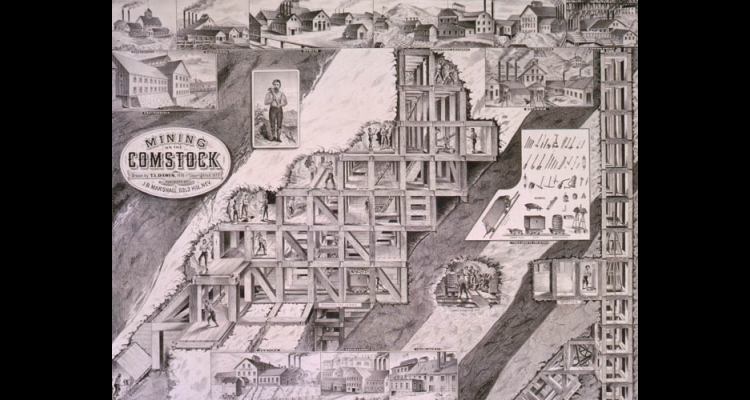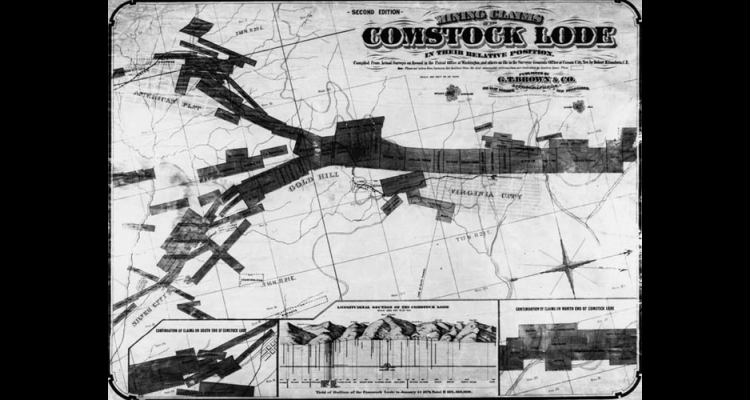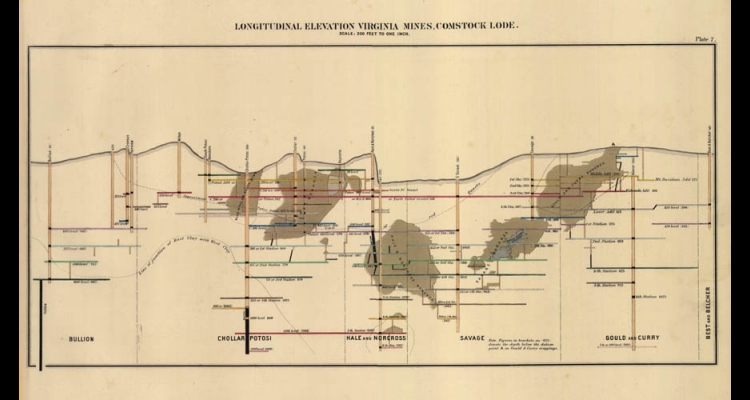Comstock Mining District
In 1849 while passing through the Great Basin to California, Abner Blackburn discovered gold at the junction of Gold Canyon and the Carson River, a place eventually called Dayton. He continued on his way, but his find marked the area for future exploration. The next year, placer miners began working gold-bearing sands in Gold Canyon.
By decade's end, miners nearly depleted the surface deposits and some left for new opportunities. Others began exploring Sun Mountain above the canyon, assuming a gold vein had decomposed for millennia, sending eroded debris down slope. Two discoveries in 1859 defined the southern and northern ends of this vein. The second, more famous of these strikes occurred on June 8, 1859 when Patrick McLaughlin and Peter O'Riley found a rich deposit of gold.
According to legend, Henry T. "Pancake" Comstock rode up in the evening and recognized McLaughlin and O'Riley's good fortune. Comstock claimed he owned the land, so they agreed to share the discovery. Because of this transaction, Comstock's name became associated with the deposit. "Lode" is a Cornish term for ore body.
The McLaughlin-O'Riley strike and the one to the south at a rich mound called Gold Hill attracted settlers from throughout the region. Miners profitably worked shallow deposits along the several miles between the two outcroppings. They complained that an "annoying blue stuff" clogged their rockers and long toms, equipment used to wash soil to retrieve gold. On June 27, 1859, Melville Atwood, an assayer in the California gold country, analyzing a Comstock rock, determined that one ton of the material would yield $876 in gold and nearly $3,000 in silver. The "blue stuff" miners had discarded for weeks was actually a rich concentrate of silver. Within days, the West experienced yet another rush.
By the fall of 1859, hundreds of settlers established Silver City, Gold Hill, and Virginia City, the latter named after James "Old Virginny" Finney, an early claimant. Word spread that Washoe, the region's widely used name, was a place of wealth. With the spring of 1860, the "Rush to Washoe" attracted thousands of fortune seekers from California and elsewhere.
Among the first to arrive was George Hearst, who eventually left Virginia City with a fortune. After the creation of the Nevada Territory in 1861, Samuel Clemens came west, accompanying his brother Orion, the new Territorial Secretary. Clemens joined the staff of Virginia City's newspaper, the Territorial Enterprise, where he assumed the name Mark Twain.
The population swelled with immigrants including Irish, Cornish, Chinese, Germans, and representatives of dozens of other nationalities. Diversity created a cosmopolitan place. From ethnic saloons to theaters, brothels, and opium dens, the Comstock offered a range of diversions. For two decades, the Comstock commanded respect throughout the mining world. Its communities boasted fine restaurants, hotels, stores, schools, and a wide range of other amenities. John Piper's Opera House and the Territorial Enterprise became nationally known for excellence. At its height in the mid-1870s, the combined population of Gold Hill and Virginia City surpassed twenty thousand, making it a sizeable community for the time.
The district was also known for its inventions. Almarin Paul established the first Comstock ore-processing mill in 1860, and many others followed. The millers invented the Washoe Pan Process to unlock the stubborn silver ore. Ophir Mine owners commissioned engineer Philipp Deidesheimer to invent a better way to support underground mines. His response was the widely used square-set timber method.
Improvements in elevator technology resulted in the development of the safety cage and of flat wire cables, later employed by San Francisco's cable cars. The nation was in awe of the Comstock's water system, its Sutro Tunnel, and its Virginia and Truckee Railroad.
The expertise required to dig down three thousand feet, to retrieve and process ore, and to bring water, lumber, and other supplies to isolated mountain mines, made the Comstock a significant technological achievement. Remote nineteenth-century mining districts throughout the world imitated its approach to industry and infrastructure.
For all its economic success, the Comstock was not without fluctuations. Initial prosperity lasted four years as shallow deposits yielded millions in gold and silver. When the mines slumped in 1864 many left for new discoveries in central Nevada. Strikes in the mid 1860s rejuvenated the Comstock. Another slump in the late 1860s inspired migration to Hamilton's prosperous mining district in eastern Nevada, but the Comstock was hardly finished.
After 1864, William Sharon, William Ralston, and their Bank of California monopolized the Comstock, controlling mines, mills, and the railroad. Irish immigrants John Mackay and James Fair, two common miners with a sense for ore, quietly obtained neglected claims and eventually challenged the Bank's stranglehold. In 1869, Mackay, Fair, and their partners James Flood and William O'Brien seized control of the Hale and Norcross Mine. John P. Jones and Alvinza Hayward soon took command of the Crown Point Mine. The setbacks shook the Bank, which collapsed within a few years.
In 1873, Mackay and Fair's hard work and ingenuity paid off with a phenomenal discovery known as the Big Bonanza, winning the district even greater recognition. Tons of gold and silver flowed into the market, affecting monetary policy as far away as Germany. Mackay and Fair became Comstock sovereigns.
Unfortunately, more bonanzas were not forthcoming. By the 1880s, the district slumped again, and only optimists lingered. Minor discoveries in 1903 helped, but soon the Comstock resumed its decline. In the 1940s, Virginia City attracted artists and bohemians including writer Lucius Beebe who resuscitated the Territorial Enterprise. From 1959 to 1974, the Comstock acquired notoriety as the focus of the television hit Bonanza.
During the early 1960s, some Bay-Area musicians retreated to the Comstock, inventing the psychedelic rock art poster and playing a key role in developing the San Francisco rock sound. The district hosted counter-culture icons such as Ken Kesey, the Charletons, and Big Brother and the Holding Company among others. Today, the Comstock is one of the most popular historic destinations in Nevada.
Article Locations
Related Articles
None at this time.
Further Reading
None at this time.


